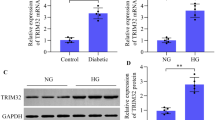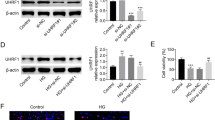Abstract
Diabetic nephropathy (DN), a serious complication of hyperglycemia, is one of the most common causes of end-stage renal disease (ESRD). Glomerular podocyte injury is a major mechanism that leads to DN. However, the mechanisms underlying podocyte injury are ambiguous. In this study, we sought to investigate the contribution of SET domain-containing protein 6 (SETD6) to the pathogenesis of podocyte injury induced by glucose (GLU) and palmitic acid (PA), as well as the underlying mechanisms. Our results showed that GLU and PA treatment significantly decreased SETD6 expression in mouse podocytes. Besides, Cell Counting Kit-8 (CCK-8) and flow cytometry assay demonstrated that silencing of SETD6 silence obviously enhanced cell viability, and suppressed apoptosis in GLU and PA-induced podocytes. We also discovered that downregulation of SETD6 suppressed GLU and PA-induced ROS generation and podocyte mitochondrial dysfunction. Nrf2-Keap1 signaling pathway was involved in the effect of SETD6 on mitochondrial dysfunction. Taken together, silencing of SETD6 protected mouse podocyte against apoptosis and mitochondrial dysfunction through activating Nrf2-Keap1 signaling pathway. Therefore these data provide new insights into new potential therapeutic targets for DN treatment.
Graphic abstract





Similar content being viewed by others
Data availability
We declared that materials described in the manuscript, including all relevant raw data, will be freely available to any scientist wishing to use them for non-commercial purposes, without breaching participant confidentiality.
References
Adamska-Patruno E, Samczuk P, Ciborowski M, Godzien J, Pietrowska K, Bauer W, Gorska M, Barbas C, Kretowski A (2019) Metabolomics reveal altered postprandial lipid metabolism after a high-carbohydrate meal in men at high genetic risk of diabetes. J Nutr 149(6):915–922
Ahmad J (2015) Management of diabetic nephropathy: recent progress and future perspective. Diabetes Metab Syndr Clin Res Rev 9(4):343–358
Belinda J, Mythili G, Andi Q, Ying F, Chuang PY, Cohen HW, Maria A, Thomas DB, He JC (2012) Dysregulated nephrin in diabetic nephropathy of type 2 diabetes: a cross sectional study. PLoS ONE 7(5):e36041
Binda O, Sevilla A, LeRoy G, Lemischka IR, Garcia BA, Richard S (2013) SETD6 monomethylates H2AZ on lysine 7 and is required for the maintenance of embryonic stem cell self-renewal. Epigenetics 8(2):177–183
Bommer J (2001) Attaining long-term survival when treating diabetic patients with ESRD by hemodialysis. Adv Ren Replace Ther 8(1):13–21
Bose M, Almas S, Prabhakar S (2017) Wnt signaling and podocyte dysfunction in diabetic nephropathy. J Investig Med Off Publ Am Feder Clin Res 65(8):1093
Cai X, Bao L, Ren J, Li Y, Zhang Z (2016) Grape seed procyanidin B2 protects podocytes from high glucose-induced mitochondrial dysfunction and apoptosis via the AMPK-SIRT1-PGC-1alpha axis in vitro. Food Funct 7(2):805–815
Cao Z, Cooper ME (2011) Pathogenesis of diabetic nephropathy. J Diabetes Investig 2(4):243–247
Chang Y, Levy D, Horton JR, Peng J, Zhang X, Gozani O, Cheng X (2011) Structural basis of SETD6-mediated regulation of the NF-kB network via methyl-lysine signaling. Nucleic Acids Res 39(15):6380–6389
Chen JJ, Xia XH, Wang LF, Jia YF, Nan P, Li L, Chang ZJ (2015) Identification and comparison of gonadal transcripts of testis and ovary of adult common carp Cyprinus carpio using suppression subtractive hybridization. Theriogenology 83(9):1416–1427
Chen A, Feldman M, Vershinin Z, Levy D (2016) SETD6 is a negative regulator of oxidative stress response. Biochimica et Biophysica Acta (BBA)s 1859(2):420–427
Cheng D, Gao L, Su S, Sargsyan D, Wu R, Raskin I, Kong AN (2019) Moringa isothiocyanate activates Nrf2: potential role in diabetic nephropathy. AAPS J 21(2):31
Choel LS, Hyeok S, Ji H, Ha LJ, Dong-Sub LS, Seung-Jae J, Hye KSeung, Ki K, Tae-Hyun KD, Hyun KJ (2009) Induction of heme oxygenase-1 protects against podocyte apoptosis under diabetic conditions. Kidney Int 76(8):838–848
Du X, Yu J, Sun X, Qu S, Zhang H, Hu M, Yang S, Zhou P (2018) Impact of epigallocatechin3gallate on expression of nuclear factor erythroid 2related factor 2 and gammaglutamyl cysteine synthetase genes in oxidative stressinduced mouse renal tubular epithelial cells. Mol Med Rep 17(6):7952–7958
Eid AA, Yves G, Fagg BM, Rita M, Barnes JL, Karen B, Abboud HE (2009) Mechanisms of podocyte injury in diabetes: role of cytochrome P450 and NADPH oxidases. Diabetes 58(5):1201
Fan Y, Yang Q, Yang Y, Gao Z, Ma Y, Zhang L, Liang W, Ding G (2019) Sirt6 suppresses high glucose-induced mitochondrial dysfunction and apoptosis in podocytes through AMPK activation. Int J Biol Sci 15(3):701
Ha TS, Choi JY, Park HY, Han GD (2013) Changes of podocyte p130Cas in diabetic conditions. J Nephrol 26(5):870–876
Herrera B, Álvarez AM, Sánchez A, Fernández M, Roncero C, Benito M, Fabregat I (2001) Reactive oxygen species (ROS) mediates the mitochondrial-dependent apoptosis induced by transforming growth factor β in fetal hepatocytes. Faseb J 15(3):741
Hou-Yong D, Min Z, Lin-Li L, Ri-Ning T, Kun-Ling M, Dan L, Min W, Bi-Cheng L (2011) The roles of connective tissue growth factor and integrin-linked kinase in high glucose-induced phenotypic alterations of podocytes. J Cell Biochem 113(1):293–301
Katalin S, Raff AC, Mario S, Bottinger EP (2006) Glucose-induced reactive oxygen species cause apoptosis of podocytes and podocyte depletion at the onset of diabetic nephropathy. Diabetes 55(1):225
Khaled A, Abdul H, Ajay S, Sanjay M, Dan R (2012) Podocyte foot process effacement in postreperfusion allograft biopsies correlates with early recurrence of proteinuria in focal segmental glomerulosclerosis. Transplantation 96(3):1238–1244
Korsmo-Haugen HK, Brurberg KG, Mann J, Aas AM (2019) Carbohydrate quantity in the dietary management of type 2 diabetes: a systematic review and meta-analysis. Diabetes Obes Metab 21(1):15–27
Lin CL, Wang JY, Huang YT, Kuo YH, Surendran K, Wang FS (2006) Wnt/beta-catenin signaling modulates survival of high glucose-stressed mesangial cells. J Am Soc Nephrol 17(10):2812–2820
Liu Y, Xu Z, Ma F, Jia Y, Wang G (2018) Knockdown of TLR4 attenuates high glucose-induced podocyte injury via the NALP3/ASC/Caspase-1 signaling pathway. Biomed Pharmacother 107:1393–1401
Michele DV, Alessandra M, Maria A, Alois R, Gaetano S, Paola F (2003) Is podocyte injury relevant in diabetic nephropathy? Studies in patients with type 2 diabetes. Diabetes 52(4):1031–1035
Mukherjee N, Cardenas E, Bedolla R, Ghosh R (2017) SETD6 regulates NF-kappaB signaling in urothelial cell survival: implications for bladder cancer. Oncotarget 8(9):15114–15125
Mundel P, Reiser J (2010) Proteinuria: an enzymatic disease of the podocyte? Kidney Int 77(7):571–580
Nakai K, Fujii H, Kono K, Goto S, Kitazawa R, Kitazawa S, Hirata M, Shinohara M, Fukagawa M, Nishi S (2013) Vitamin D activates the Nrf2-Keap1 antioxidant pathway and ameliorates nephropathy in diabetic rats. Am J Hypertens 27(4):586–595
Palsamy P, Subramanian S (2011) Resveratrol protects diabetic kidney by attenuating hyperglycemia-mediated oxidative stress and renal inflammatory cytokines via Nrf2–Keap1 signaling. Biochimica et Biophysica Acta (BBA) 1812(7):719–731
Qiao C, Ye W, Li S, Wang H, Ding X (2018) Icariin modulates mitochondrial function and apoptosis in high glucose-induced glomerular podocytes through G protein-coupled estrogen receptors. Mol Cell Endocrinol 473:146–155
Sanjay J, Laura DP, Masato H, Shreeram A, Rajshekhar C, Helen L (2011) Expression profiles of podocytes exposed to high glucose reveal new insights into early diabetic glomerulopathy. Lab Invest 91(4):488–498
Sasaki K, Doi S, Nakashima A, Irifuku T, Yamada K, Kokoroishi K, Ueno T, Doi T, Hida E, Arihiro K (2016) Inhibition of SET domain-containing lysine methyltransferase 7/9 ameliorates renal fibrosis. J Am Soc Nephrol 27(1):203
Shen Y, Chen S, Zhao Y (2019) Sulfiredoxin-1 alleviates high glucose-induced podocyte injury though promoting Nrf2/ARE signaling via inactivation of GSK-3β. Biochem Biophys Res Commun 516(4):1137–1144
Shih AY, Imbeault S, Barakauskas V, Erb H, Jiang L, Li P, Murphy TH (2005) Induction of the Nrf2-driven antioxidant response confers neuroprotection during mitochondrial stress in vivo. J Biol Chem 280(24):22925–22936
Siu B, Saha J, Smoyer WE, Sullivan KA, Brosius FC (2006) Reduction in podocyte density as a pathologic feature in early diabetic nephropathy in rodents: prevention by lipoic acid treatment. Bmc Nephrol 7(1):6–6
Tagawa A, Yasuda M, Kume S, Yamahara K, Nakazawa J, Chin-Kanasaki M, Araki H, Araki S-I, Koya D, Asanuma K (2016) Impaired podocyte autophagy exacerbates proteinuria in diabetic nephropathy. Diabetes 65(3):755–767
Vershinin Z, Feldman M, Chen A, Levy D (2016) PAK4 methylation by SETD6 promotes the activation of the Wnt/β-catenin pathway. J Biol Chem 291(13):6786–6795
Villeneuve LM, Kato M, Reddy MA, Wang M, Lanting L, Natarajan R (2010) Enhanced levels of microRNA-125b in vascular smooth muscle cells of diabetic db/db mice lead to increased inflammatory gene expression by targeting the histone methyltransferase Suv39h1. Diabetes 59(11):2904–2915
Wang D, Dai C, Li Y, Liu Y (2011) Canonical Wnt/β-catenin signaling mediates transforming growth factor-β1-driven podocyte injury and proteinuria. Kidney Int 80(11):1159
Wang C, Li C, Peng H, Ye Z, Zhang J, Liu X, Lou T (2014) Activation of the Nrf2-ARE pathway attenuates hyperglycemia-mediated injuries in mouse podocytes. Cell Physiol Biochem 34(3):891–902
Wang Y, Xue J, Li Y, Zhou X, Qiao S, Han D (2019) Telmisartan protects against high glucose/high lipid-induced apoptosis and insulin secretion by reducing the oxidative and ER stress. Cell Biochem Funct 37(3):161–168
Xu Z, Wei Y, Gong J, Cho H, Park JK, Sung E-R, Huang H, Wu L, Eberhart C, Handa JT (2014) NRF2 plays a protective role in diabetic retinopathy in mice. Diabetologia 57(1):204–213
Zhang S, Qiu X, Dong S, Zhou L, Zhu Y, Wang M, Jin L (2019) MicroRNA-770-5p is involved in the development of diabetic nephropathy through regulating podocyte apoptosis by targeting TP53 regulated inhibitor of apoptosis 1. Eur Rev Med Pharmacol Sci 23(3):1248–1256
Funding
The study was approved by Shaanxi Provincial Health and Family Planning Commission Scientific Research Fund (2016D018), the National Natural Sciences Foundation of China (81473010) and Shaanxi Province Key Research and Development Project fund (2018SF-173).
Author information
Authors and Affiliations
Contributions
XW, CXH and RL conceived and designed the study, and revised the draft; QLL and SW contributed to the acquisition, analyses, and interpretation of data; XW, QLL, DQK and ZL performed the cell culture and transfection experiments; XW, QLL, and YFG designed the experiments, performed data analyses, and drafted the manuscript. All authors contributed to writing the manuscript, reviewed and approving the final version. All persons designated as authors qualify for authorship, and all those who qualify for authorship are listed.
Corresponding authors
Ethics declarations
Conflict of interest
The authors declare no conflict of interest.
Additional information
Publisher's Note
Springer Nature remains neutral with regard to jurisdictional claims in published maps and institutional affiliations.
Electronic supplementary material
Below is the link to the electronic supplementary material.
Rights and permissions
About this article
Cite this article
Wang, X., Liu, Q., Kong, D. et al. Down-regulation of SETD6 protects podocyte against high glucose and palmitic acid-induced apoptosis, and mitochondrial dysfunction via activating Nrf2-Keap1 signaling pathway in diabetic nephropathy. J Mol Hist 51, 549–558 (2020). https://doi.org/10.1007/s10735-020-09904-6
Received:
Accepted:
Published:
Issue Date:
DOI: https://doi.org/10.1007/s10735-020-09904-6




